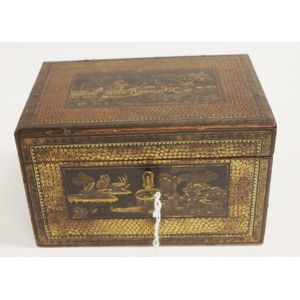Victorian Chinoiserie Tea Caddy with Twin Compartments
You must be a subscriber, and be logged in to view price and dealer details.
Subscribe Now to view actual auction price for this item
When you subscribe, you have the option of setting the currency in which to display prices to $Au, $US, $NZ or Stg.
- Chinoiserie - Furniture and decorative items decorated in imitation of a Western interpretation of the Chinese style. The Chinoiserie style first became popular in the late 17th century, though there were frequent revivals, notably by Chippendale (hence 'Chinese Chippendale') during the Regency period, and the Anglo-Japanese style in the second half of the 19th century.
The ubiquitous 'willow pattern' is the most common 'Chinese' theme used in porcelain, while on furniture the Chinoiserie style usually has black or red painted and lacquered decoration, though the hallmark of the furniture style is the use of fretwork in geometrical patterns, pagodas and other decorative forms.
Japonaiseries, as the name implies, are motifs in imitation of the Japanese taste.
See also "Chinese Chippendale". - Victorian Period - The Victorian period of furniture and decorative arts design covers the reign of Queen Victoria from 1837 to 1901. There was not one dominant style of furniture in the Victorian period. Designers used and modified many historical styles such as Gothic, Tudor, Elizabethan, English Rococo, Neoclassical and others, although use of some styles, such as English Rococo and Gothic tended to dominate the furniture manufacture of the period.
The Victorian period was preceded by the Regency and William IV periods, and followed by the Edwardian period, named for Edward VII (1841 ? 1910) who was King of the United Kingdom and the British Dominions and Emperor of India for the brief period from 1901 until his death in 1910. - Circa - A Latin term meaning 'about', often used in the antique trade to give an approximate date for the piece, usually considered to be five years on either side of the circa year. Thus, circa 1900 means the piece was made about 1900, probably between 1895 and 1905. The expression is sometimes abbreviated to c.1900.
This item has been included into following indexes:
Visually similar items

An Arabian style studded teak blanket chest, early to mid 20th century, decorated in Eastern style studded geometric designs to top and front panel chest interior has a candle box to one side; lower underneath is a secret hidden compartment chamber. Height

Three sarcophagus shaped tea caddies, 19th century, each of varying size, two raised on bun feet with ring handle details, the other with Tunbridge inlay, 20 cm, 16.5 cm and 13.5 cm respectively

A Victorian writing slope, the walnut box with an inlaid border of parquetry dentil work, lid opens to reveal ink and pen compartments and the secret drawer, further mother-of-pearl and inlay work to top and keyhole escutcheon. 50 x 25.5 x 17 cm

An intriguing Anglo-Indian timber and brass jewellery box, late 19th century, with an arabesque decorated lid, brass edges and recessed bracket handles, the fine interior fitted with a series of drawers, removable trays, boxes, some inlaid, and fold out co
